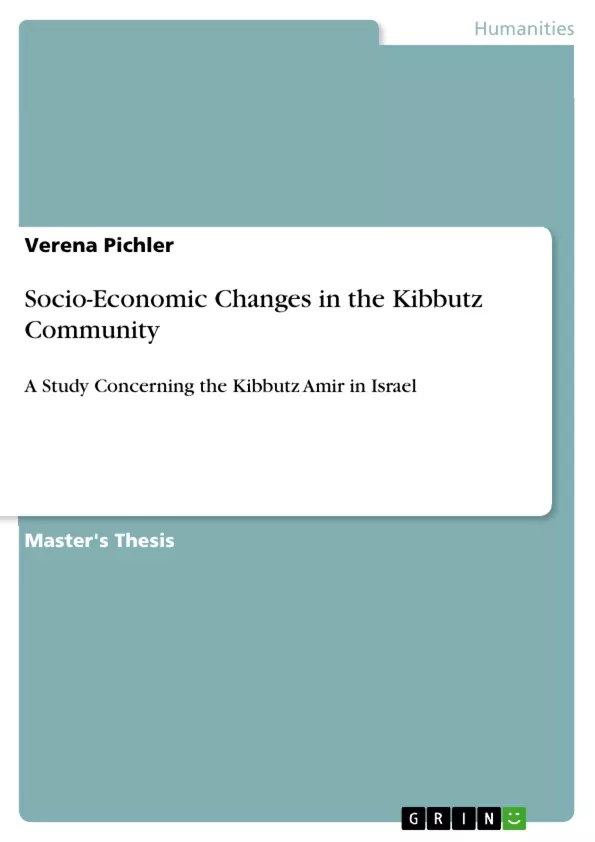This study seeks to examine the socio-economic changes experienced in the Kibbutz Amir in Israel. At the same time, it wants to offer clarity on the academic and societal significance amidst the changes experienced. As such, the study aims to investigate the Kibbutzim ideology and the implication of the changes that are embraced after the collapse of the agrarian-social system practiced by the community members in this context. In order to understand the implication of these changes, a qualitative approach will be embraced, with the recruited members from the Kibbutz community participating into face-to-face interviews.
The complexity of the Kibbutzim socialism model is attributed by different studies that account for the livelihoods of the people at the Kibbutz. The Kibbutz was based on a phenomenal strategy according to which everyone was equal and that property was communal. The community attributed the Kibbutz as a large family, which the socialism manifested by sharing job roles and even sharing clothes.
The socialist model accounts for the social values of collectiveness and equality among members of a community. Faced with social pressures and economic constraints, the Kibbutz Amir went through significant phases and as the change took effect, the traditional equalitarian model was disbanded. Therefore, the present study seeks to understand the experiences, thoughts, and perceptions of the members of the Kibbutz Amir regarding the phases and the implication of the changes. This study utilizes a qualitative research method to collect data from the research subjects selected purposively.
Table of Contents
- CHAPTER ONE: INTRODUCTION
- 1.1. Research Question
- 1.2 Research Aim
- 1.3 Research Objectives
- CHAPTER TWO: LITERATURE REVIEW
- 2.1 Review of Literature
- 2.1.1 Kibbutz community as a Utopian community model
- 2.1.2 Characteristics of Kibbutz Community
- 2.2 Theoretical Perspective
- 2.2.1 Theory of Change
- 2.2.2 Model of Equality: A Kibbutz-level Case
- 2.2.3 Crisis and Reform model
- CHAPTER 3: RESEARCH DESIGN AND METHODS
- 3.1 Method
- 3.2 Population and Sampling
- 3.3 Data Collection and Interview Process
- 3.4 Data Analysis
- 3.5 Ethical Issues
- 3.6 Limitations
- 3.7 Chapter Summary
- CHAPTER 4: FINDINGS
- 4.1 Overview
- 4.2 The Kibbutzim Ideology
- 24.2.1 Understanding the Kibbutzim
- 4.2.2 Challenges
- 4.2.3 Changes Presented in the New Kibbutzim
- 4.2.4 Significant Changes
- 4.3 Cultural Diversity
- 4.3.1 Family Life
- 4.3.2 Equality and the Role of Men and Women
- 4.3.3 Privacy and Independence
- 4.3.4 Issue of multi-culturalism
- 4.4 The Economic Perspective
- 4.5 The Educational Perspective
- 4.6 Chapter Summary
- CHAPTER 5: DISCUSSION AND CONCLUSION
- 5.1 Summary of this Study
- 5.2 Discussion of the Findings
- 5.2.1 The Kibbutz Ideology
- 5.2.2 The Cultural and Educational Diversity
- 5.2.3 The Economic Perspective
- 5.3 Implications and Future Research
- 5.4 Future Research
Objectives and Key Themes
This master's thesis explores the socio-economic changes that have occurred in the Kibbutz Amir, Israel, investigating the experiences, thoughts, and perceptions of its members regarding these transformations. The study aims to understand the impact of these changes on the traditional equalitarian model of the Kibbutz, which was based on socialist principles of collectiveness and equality.
- The evolution of the Kibbutz model from its socialist origins to its current state.
- The impact of social pressures and economic constraints on the Kibbutz community.
- The experiences, perceptions, and attitudes of Kibbutz members regarding the changes they have witnessed.
- The role of cultural diversity and the changing roles of men and women in the Kibbutz context.
- The economic and educational perspectives of the Kibbutz community in relation to the changes.
Chapter Summaries
Chapter One introduces the research question, the aim, and the objectives of the study. It establishes the context for the investigation by highlighting the significance of understanding the changes experienced in the Kibbutz Amir.
Chapter Two delves into the existing literature on the Kibbutz community. It explores the Kibbutz as a utopian community model, its characteristics, and the theoretical frameworks relevant to understanding its transformation. The chapter examines theories of change, models of equality, and the crisis and reform model.
Chapter Three outlines the research design and methods employed in the study. It details the population and sampling techniques, data collection process, data analysis methods, and ethical considerations. It also discusses the limitations of the research.
Chapter Four presents the findings of the study, providing an overview of the Kibbutz ideology, cultural diversity, economic perspective, and educational perspective. It explores the challenges, changes, and significant shifts observed in the Kibbutz Amir.
Keywords
This study revolves around the concepts of Kibbutz, its transformations, the impact on the community, and the cultural, economic, and educational aspects of these changes. Key terms include Kibbutz, changes, community, Israel, society, equality, collectivism, social pressures, economic constraints, cultural diversity, and education.
- Quote paper
- Verena Pichler (Author), 2018, Socio-Economic Changes in the Kibbutz Community, Munich, GRIN Verlag, https://www.grin.com/document/449008



